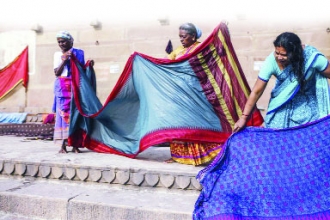
By linking sari to Hindu nationalism, Qadri has offended the sensibility of millions of Indians. He is a symbol of a chronic ailment that has plagued the Western media
A person claiming to be born in “Indian-controlled Kashmir” draped one of India’s eternal cultural symbol ‘sari’ into a political colour. In a desperate attempt to denigrate India’s cultural pride, Asgar Qadri, the New York Times writer, made a rather bizarre proposition, blaming “rise of Hindu nationalist politics” as a major obstacle to “realising the country’s promise of growth”, including that of the fashion industry. As if with vengeance, he blamed Prime Minister Narendra Modi and Textiles Minister Smriti Irani for safeguarding and promoting interests of India’s most critical industries. This is no coincidence, and perhaps, the writer can never appreciate the fact that both these ‘personalities’ come from a State whose capital has been known as Manchester of India. What’s bizarre, the writer accused the two of protecting the textile and apparel sector, which according to Assocham, is the second largest employment provider in the country, employing nearly 51 million people directly and 68 million people indirectly in 2015-16.
Resembling an aggrieved agent of global luxury brands, and seemingly peeved at more Indians basking in nationalistic pride than ever before, Qadri took distortions to a new high by claiming that “since the Bharatiya Janata Party formed a national Government in 2014, the Indian fashion industry has been pressed to aggressively promote traditional attire and bypass Western styles.” Much like his bigoted counterparts in India, who choose coloured prisms to analyse emergence of a ‘New India’ under Prime Minister Modi, Qdari went on to write, “The effort aligns with the party’s broader political programme: To project multi-faith India, a country of more than 1.3 billion, as a Hindu nation.”
Prime Minister Modi and Irani are both right in their aggressive safeguarding of India’s $150 billion textiles industry, which accounts for 10 per cent of the country’s manufacturing production, five per cent of India’s gross domestic product, and 13 per cent of India’s exports earnings — there is nothing Hindu in it, for the industry employs and sustains people of all religions.
Preferring to overlook historic social reforms initiated by the Prime Minister, including one that ends the age-old scourge of Muslim women being subjected to oppression through triple talaq, Qadri exaggerated stray incidents and made sweeping generalisations. “Critics of Modi have been branded as anti-national, some shot and killed by Hindu nationalist activists,” he wrote. Naturally, he prefers not to look at far more lynchings of the same Hindu nationalists in Kerala and West Bengal. A visibly biased and prejudiced Qadri accused even Mahatma Gandhi and Jawaharlal Nehru of politicising traditional clothing and rued that “active state intervention and patronage of the fashion industry have never before reached this scale.”
Qadri is naive in imagining that the fashion industry of a nation as vibrant as India, thrives in isolation. In fact, many Indians today take pride in the fact that the state is responsive to the industry and is giving it the much-needed window of reforms and rejuvenation. But that does not mean that the state is suppressing international luxury brands, a weird logic Qadri seems adamant at pushing. He just needs to Google to find out that in recent past, many global luxury brands, including Women’s Secret (Spain), Springfield (Spain), Simon Carter (Britain), Onitsuka Tiger (Japan), Cifonelli (French) have made their forays into India.
The New York Times writer also blatantly ignored the historic reforms by the Modi Government on Foreign Direct Investment, including the dismantling of Foreign Investment Promotion Board, which has thrown open new possibilities for international luxury brands. In fact, many big international apparel and manufacturing players have invested in India already, including textile machinery manufacturers Rieter and Trutzschler, and vertically integrated fashion brands like Zara and Mango (Spain), Promod (France), Benetton (Italy), Esprit, Levi’s and Forever 21 (US).
Perhaps Qadri does not realise, by subtly taunting the choice of sari as an enduring attire by Irani and bizarrely linking it with Hindu nationalism, he has offended sensibilities of millions of Indian women, of all religions, and he should surf Twitter to find how enraged the country has been over his undignified remarks.
Qadri, in fact, symbolises a chronic ailment that has plagued the Western media — of trivialising India and Indian-ness — and looking it with predetermined bullock-cart and snake-charmer prisms. The trend gets louder and more envious as India begins to get stronger, politically, economically and culturally. And even as a tiny fringe bemoan, the rise of Modi back home, some of their disgruntled cousins in likes of Qadri do the brow-beating elsewhere. What a disgrace, a reputed American daily becomes a party to this shameful denouncement of the idea of India.
(The writer is a strategic communications professional)














